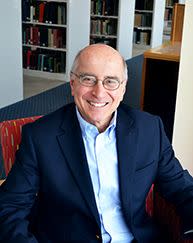Harry Paidas: Taking on history update offered much information

Even though I have been writing and producing public documents most of my life, such as this column, I have never considered myself an author.
The term “author” in my mind is reserved for those who write books and lengthy articles requiring meticulous research to support their writing. Though I have been content to be a writer/contributor of news articles and feature stories, I have wondered what it would be like to be an author.
So, when Mount Union President Tom Botzman contacted me last summer about the possibility of updating Mount Union history in the form of a book to complement the two previous volumes “A Select School” by N. Yost Osborne and “Wake the Echoes” by John Saffell, I was flattered but somewhat tentative about agreeing to the project.
Botzman explained that he thought I was the right person for the project because I had direct experience for the time period to be covered (1996-2021) since I had worked at Mount Union from 1983 until my retirement in 2016. He further flattered me by stating that there were those on campus who thought I was the right person for the job because they enjoyed my writing.
My reticence about agreeing to the project was due to several factors. First, I am not a historian, as the two previous authors were. They were historians who wrote well; I consider myself a journalist (one of those enemies of the people who produce fake news) who has an interest in history. Thus, as I explained to the president, this third volume would be different than the previous two.
I also was reluctant because, although I was often “in the room where it happened” during the era I was asked to cover, I was uncomfortable with some of the decisions that had been made. Also, realizing that this book was to be historically accurate, I could not rely on memory alone, which meant I had to conduct significant research to be credible. Ugh.
After several days of mulling over the request, I accepted the challenge.
Fast forward to the present and I can tell you that my fears were well-founded, but I am pleased, with the end in sight, to report that the book “Make the Echoes Roll” should be ready by Christmas. By researching and recounting the past 25 years, I discovered things about myself and uncovered things about Mount that I had either forgotten or never knew.
The past 18 months were supposed to be spent in retirement. Instead, I had both the pleasure and tedious task of trying to recreate what arguably was the most active two and a half decades in the college’s history. During the time I was at Mount, I reported directly to five of the 13 presidents and was a colleague of President Botzman when he was a faculty member.
I had my favorites, but the reader of the book will have to determine who they were by reading between the lines. Because, unlike this column where I have license to openly express my opinion, a book of this nature needs a more neutral tone that is top-heavy with facts.
With only proofreading and last-minute changes remaining before the book goes to press, I wanted to share some of the top tidbits that amazed me despite having been close to the scene during those years:
First, in 1996, the year the book technically begins, Mount is at a crossroads with technology. Decisions included hard wiring vs. wireless; PCs vs. Macs; extent of involvement with the internet; extent of online learning; and what the library of the future should look like. Fortunately, President Harold Kolenbrander was able to rely on John Kirchmeyer, Mount’s technology guru, and Jim Klayder, a faculty member who had the foresight to anticipate the impact of the internet, and the decisions Kolenbrander made were spot-on, giving Mount a head start during the technology revolution.
Next, athletics, specifically football, were about more than wins and losses. The success of the athletic program during this era gave the institution national attention and helped drive enrollment and endowment to record levels. The football success has been amazing and unprecedented in college athletics at any level. Overshadowed, but not insignificant, was the rise of women’s athletics during the past 25 years. Moreover, had it not been for football capturing the headlines in the sports pages, Mount’s track program would be a bigger national story than it has been. What track and field teams have accomplished during the past 50 years under three coaches is remarkable.
Finally, the academic program went through a seismic shift. In 1996, Mount was still describing itself as a liberal arts school, and though professional majors had infiltrated the curriculum, it was still largely an undergraduate college of teachers, preachers and other professionals. In 2021, Mount Union is a small university offering successful graduate programs with popular undergraduate majors in engineering and nursing. In fact, nursing, which didn’t exist until 2013, is now the No. 1 major at Mount.
I have obviously had a lot of help putting this volume together. In doing so, I had a chance to renew acquaintances, recount memorable events and was able to put down on paper a lasting chronicle that puts an exclamation point on the last 25 years of a 175-year history.
And I confirmed that being an author is a whole lot different than being a columnist – and a lot more work.
Harry Paidas is faculty emeritus at Mount Union and writes a monthly column for The Review. He can be reached at paidashp@mountunion.edu.
This article originally appeared on The Alliance Review: Harry Paidas: Taking on history update offered much information